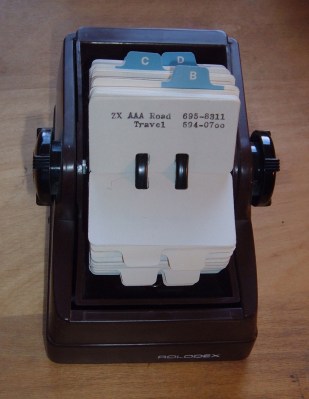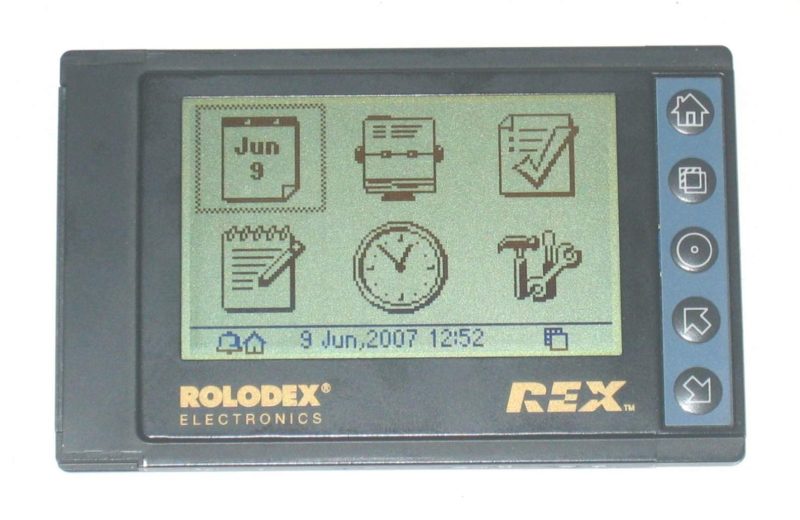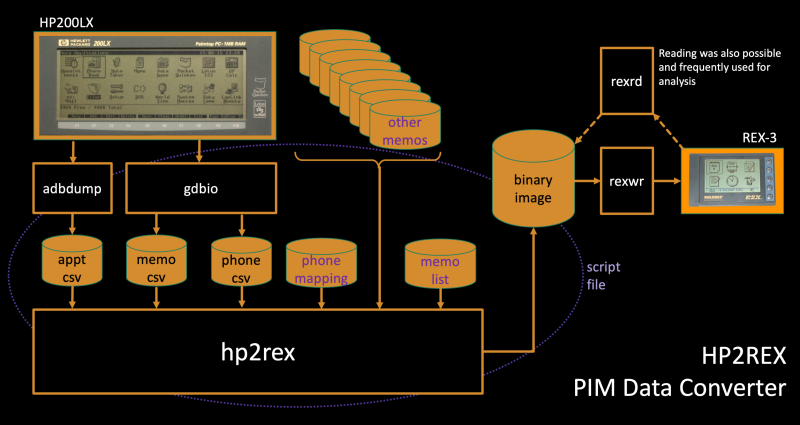Back in the 1990s I was fascinated with small computers. I used the HP200LX palmtop computer for almost ten years, which I wrote about back in December. Naturally, the Franklin Rex 3 PCMCIA-sized organizer caught my attention when it was released in 1997. Here was a Personal Digital Assistant (PDA) the size of a credit card that could fit not just in your pocket, but in your shirt pocket.
Viewed today, it was an interesting paradigm. The screen takes up almost the entire front face of the device with a few buttons for navigation. But isn’t it a deal-breaker that you can’t enter or edit contact info on the device itself? This was long before cellphones were pervasive, and if you had the option to connect to the internet a telephone or Ethernet cable was involved. The ability to have a large data set in your pocket viewable without slapping a brick-like laptop on a table was pretty huge.
I think the killer feature was the PCMCIA interface. I challenged myself to reverse engineer the API so that I could sync data outside of the
Wait, What’s a Rolodex?

Some of us might remember the Rolodex, a once-popular paper version of today’s contacts databases we all have on our phones and computers. The Rolodex, a portmanteau of “rolling” and “index”, was patented in 1956 by Hildaur L. Neilsen of the Zephyr American Corporation in New York City. The frame of a Rolodex holds specially notched index cards which snap onto two rings, allowing the user to find a desired contact by rotating the whole stack of cards using one of the big wheels on either side. Contact information can be written or typed on blank cards, or special sleeve cards can be used to hold business cards. Despite being featured in museums these days, the Rolodex company is still around and selling both frames and cards; even offering downloadable templates so you can make your own cards at home.
In some professions like sales and journalism, one’s Rolodex is a treasured possession, containing years of accumulated contacts which is literally or figuratively lugged from job to job. With the advent of personal computing, these lists have shifted to electronic form. While putting a contact list on your computer was straightforward and very useful, being able to carry your list around in your pocket was even more so (remember, this was before most people had a cell phone, much less a smart phone). In the 90s several small, electronic Rolodex-like products were introduced, but none became very popular.
Awkward Attempts at Digital Replacements
As the computer age dawned, companies scrambled to become the replacement for the original Rolodex. Some were just like computers, others more like pocket calculators.
The Franklin Computing company released a pair of Apple II clones in early 1982. You might not be familiar with the Franklin Ace 100 or 1000, but their legal battle with Apple sent ripples throughout the software community that we still feel today. The United States Court of Appeals ruled in 1983 that a computer’s operating system and the associated binary code were both copyrightable.

This pushed Franklin’s focus away from computers to hand-held electronic devices such as the Spelling Ace pocket dictionary, the Language Master pocket translator, and the eBookMan. Prior to making the Rex, Franklin also made a few small pocket organizers and had an exclusive license to the Rolodex trademark.
Across the ocean the Japan CBM Corporation, part of Citizen Watch, was making electronic calculators, pocket television receivers in the 1980s. They also had a family of small “Memory Bank” devices. These were credit card sized, but had a limited memory capacity and a small display.
The Rise and Fall of Rex
The Rex was different. It was like a piece of your desktop computer that you could take with you. But most importantly, it was easy to keep it up-to-date.
The story of Rex hinges on a familiar name. Anyone into computer programming at this time has no doubt heard of Philippe Kahn, the inventor of Turbo Pascal and founder/CEO of the software giant Borland. Although he was very publicly ousted out by the board in 1994, he was allowed to take Borland’s Sidekick and Dashboard products with him to his new company, Starfish Software. Starfish focused on synchronization IP and software, and teamed with Franklin and Citizen to introduce a new pocket-sized organizer.

The name Rex is a diminutive of the name Rolodex, quite appropriately as the form factor itself is a physical diminutive of the real thing. Previous electronic Rolodexes sacrificed display size to make room for a barely functional set of input keys. Kahn’s Rex took the opposite approach, forgoing any input method and maximizing the display area. This wasn’t as bad an idea as it might seem, if you concede that the device was going to be used just for reference and would be updated from your computer. And while the form-factor was (and still is) certainly eye-catching, from Kahn’s perspective, his new synchronization technology TrueSync was the real star of the show.
The one-way transfer of data from your PC to a small organizer might seem simplistic, but that was just a small subset of TrueSync. It was created to provide wired and wireless data synchronization between your devices, a task which required not only solving the technical issues but taming the Tower of Babel represented by the many different and incompatible data exchange formats of the day. TrueSync spawned SyncML and an industry group which standardized the exchange of data and device management.
Making a Splash
Not surprisingly, the catchy design and size of the Rex made a big splash when it was introduced in 1997. The Rex-3 had a whopping 256 kB of storage (there was a very short-lived Rex-1 with only 64 kB, so elusive that collectors aren’t even sure it was ever sold on the market). But only a year later, things began to unravel. Starfish was sold to Motorola and Franklin reported a devastating loss for which they blamed the Rex. The whole business was sold to Xircom in 1999, and they in-turn sold it to Intel the following year. Intel finally killed the product in 2001.

A few iterations of the design and model names happened during all this reshuffling of owners. The Rex Pro/Rex-5000 model was introduced in 1998 which added a modest input ability, and doubled the memory to 512 kB, and had a faster processor. A version was even made which snapped on to a Motorola StarTEC flip phone. Xircom did a complete overhaul, releasing the Rex-6000 in 2000. They kept the form-factor, but replaced the guts with a Citizen DataSlim-2. This was a surprisingly capable and extensible PDA, with a well-established community of Japanese developers. But it was too late — consumers had turned their attention to easier-to-use Palm Pilots.
Hacking the REX Interface: HP2REX
When I got my hands on a Rex and I couldn’t stop thinking about interfacing it directly with the HP200LX that I featured in a recent article because it has it’s own PCMCIA slot. While it could sync over RS-232.
Alas, the interface specs were not available for either interface. Just as I was about to give up, I discovered a group of people in Germany who were investigating the Rex format. I decided that I would build upon their efforts and make a program to sync the HP-200LX personal organizer data to the Rex3.

There were two layers of obfuscation to contend with. The memory of the Rex consisted of a number of 1K memory blocks. A contiguous flat memory space was made up of a number of these blocks which were in a big, doubly-linked list. Adding to the fun, all blocks weren’t necessarily full. This was done no doubt to make the job of inserting and deleting data fast, without having to shuffle around blocks of memory needlessly.
Once you grasped the lower layer, there were others formats to tackle, one for each kind of data — phone contacts, calendar appointments, memos, to-do lists, time zones, and preferences. Each kind of data resided in different sections of this flat memory space. I spent months decoding these formats in order to fill out the missing fields from the German group’s efforts. I still recall that decoding the different kinds of repeating appointments gave me not only headaches but an appreciation of the complicated logic involved in what would seem to be a simple thing.
I supposed one could have written a single do-it-all app, but instead I took the piecemeal approach. Unlike the Rex, the PIM formats on the HP200LX were not secret. Several tools already existed to import/export the native format from/to CSV files. I enlisted the help of fellow HP Palmtop developer Mack Baggette to write the PCMCIA interface code for me, since he already had experience talking to that port. My program HP2REX utilized these tools to perform the transfer of PIM data from the HP200LX and to the Rex, so it only focused on the translation algorithms. It was bundled inside an example script file to give the convenience of a single-command operation. In everyday use, there was really no synchronization going on, since the Rex3 didn’t have editing abilities. Every time you synced to the Rex, I basically blew away the contents and wrote a fresh copy. But reading data from the Rex was possible, indeed essential, for cracking the formats.
The latest release from 2001 is posted on Github for the curious.
Where Are They Now?
 The Rolodex company is still around and still selling the famous index frames and paper cards. After a merger and relocation to Hong Kong, the newly-named Franklin Electronic Publishers company manufactures small pocket-sized reference devices to this day. Citizen still makes calculators, and their discontinued Dataslim-2 PDA still has a niche following.
The Rolodex company is still around and still selling the famous index frames and paper cards. After a merger and relocation to Hong Kong, the newly-named Franklin Electronic Publishers company manufactures small pocket-sized reference devices to this day. Citizen still makes calculators, and their discontinued Dataslim-2 PDA still has a niche following.
Philippe Kahn is perhaps the most interesting member of the Rex team. The subsequent purchase of Starfish/TrueSync by Motorola suggests he correctly foresaw data synchronization as the real problem, not the hardware. But even before grass began growing on the Rex’s grave, Kahn was off on another invention spree. He is credited with the sending the first cell phone snapshot of his daughter’s birth from the maternity room to 2000+ friends (check out the re-enactment video at the end of that Spectrum article). Time magazine selected this photo for their The Most Influential Images of All Time collection.

His fascination with sending photos by phone led to the start of LightSurf in 1998, a multimedia messaging solutions provider. Ever restless, in 2005 Kahn created yet a fourth company, Fullpower Technologies, which focuses on sensors and IoT. He seems to have finally settled down, having stayed with Fullpower until the present day.
As for the Rex? Well, except in the hands of a few collectors and the curious, I’d have to say the Rex is dead. But if you think about it, all the core aspects of the Rex, except for its tiny size, live on in today’s smartphones. If you ever used one of these credit-card sized devices, share your story in the comments below.

















I have one Rolodex. I have sold some on eBay. What a cool device was back then, but Intel killed it. I believe intel wanted the developers, not the product.
Also I had the Xircom Rex
https://www.youtube.com/watch?v=StSW1Mw5J4c
Another useful PDA for me was a Casio PVS-400 Plus.
The battery life was a significant point.
https://www.youtube.com/watch?v=8p4unIJX1ds
I have a Rex 3 still sealed in the box. Wonder how much I can get for it.
Damn that dude in the pic is an absolute unit
That comment was posted by another [Ren]
What do you mean another Ren… I’m Ren, what makes you more Ren than others?
LOL
That RF400 reminds me a lot of the Casio SF4600B that I still use after nearly 30 years (you may wonder why but the batteries last for a couple of years and I like vintage tech that keeps on trucking, which is why my phone is a Nokia 2680)
Sync really is the critical element. Electronics is highly reliable at actually *doing* things, but old fashioned stuff still seems to beat it at *not* doing things, say, for instance, like losing your data.
I haven’t touched anything like a paper address book in years, but I wouldn’t trust digital if it didn’t have all the sync infrastructure. Those early standalone mini organizers were cool, but digital data that can’t be backed up isn’t the best plan.
Paper address books are also rarely backed up – it involves either lots of writing or lots of photocopying. And the data is easily lost, just a spilt cup of coffee…
I had both Rex 5000 and Rex 6000. I even wrote some programs for the latter. Both devices were practically useless (at least for me), but as a gadget maniac I loved them anyway.
I collected bought a Rex when it was current, and collected a couple more on Ebay years letter just for the “cool gadget” factor. It’s one of those products that looks great in concept, but falls flat in day-to-day use.
The product’s days were numbered with the advent of USB, which displaced the PC-Card slots the product depended on.
I’ve been wanting one of these for years.
I uploaded books in TXT format to Rex 5000 as memos, it was my first ebook reader.
But if I give up my Rolodex where will I keep the addresses of Zoroastrians and Alienists?
A couple of weeks ago I was cleaning out my attic and ran across my old rex, complete with box and stand. Actually I think I have 2 of them. I have started to throw them away, several times, when I run across them, because they are essentially useless to me today because I have no way to update the information in them. Still, I have kept them because they were so cute and I loved them in their day. Also, since they are still in the box and not rattling around in the back of a drawer I have somehow managed to resist throwing them away.
All of this is a problem since I am a techno Pack Rat and have been trying to lighten my accumulation of stuff. At 686 years of age you either lighten the load or start thinking about how much crap you want to inflict on your surviving relatives. I actually like my relatives so on it goes. Next time I’m in the attic staring at the accumulation of my lifetime obsessions, I will move the Electronic Pong game, pick up the REX, think about this article, look longingly at the wastebasket, and probably put the REX back on the shelf.
I’m with you (in both age and accumulation propensity) but belay that trash can – eBay is your friend. My plan is to make a deal with the nearest underemployed person I know to eBay all the gadgets I’ve accumulated over the years and split the profit.
Not that you’ll get much – old technology does not retain value worth a damn. I’ve got a lot of 8″ floppy drives that are worth less than the cost of shipping.
Synchronization is the correct challenge. It should also be mentioned that software compatibility was another challenge – getting this stuff to sync with a PC’s larger calendar app was eventually a non-starter (looking at you, IBM’s dismal Borland adventure), but somehow we all made it work.
My first organizer was a TI-6155si which, although unimpressive in terms of graphics, actually could keep a calendar updated, keep me on time for meetings and events, keep addresses, and could be interfaced painlessly with a PC to make it ergonomically possible. From there it was the whole sequence of Palm devices (eventually synced with Bluetooth before it was cool) ever willing to keep the ADD character from getting too buried in his work…
I think the HP200LX was the only device I actually used for contacts prior to phones taking over. I had a Radio Shack Something like the REX, probably a Citizen or clone.
Until e-mail was wide spread the only times I’d need a contact was to post a letter or call someone. Both done from home, which made a gadget like this a frustrating replacement for scratch paper.
I did run a Zaurus handheld computer for a while too, but that got more of a workout as a small WiFi debugger. One of the clamshell models would’ve been awesome.
When we built the REX at Franklin, it was a digital miracle of form factor. Getting an LCD with that much info on it wasn’t easy. But I used it every day and even got a sterling silver case from the Presdident of Christofle Silver who love his so much he built himself a case and then sent one to me during my tenure as CEO. We sold it to Xircom which kept it going, but intel had some sort of noncompete in the PDA area, so when they bought Xircom they killed the product. It was also a wondrful piggyback for the Motorola Startac, with Phillippe Kahn’s help on the starfish sottware. Stiil one of the favorite products I’ve ever worked on.
Wow, you actually worked on the team, Howard! I bet you have a lot of interesting stories!
Can you answer a question for me? If you look at the lead photo, the upper right corner has a rectangular “something” burned into the screen. This doesn’t appear to be related to any normal display graphics, and it appears identically on two different units I have. I’m not even sure that it is the LCD, could it be something underneath it bleeding through?
Howard, thank you for the kind words. Perhaps if you can recall you can share the full story of how Starfish, Citizen and Franklin came together. It’s a good story! Thank you for believing in the vision!
I think I had one of these – meticulously loaded it up, put it in my back pocket, sat down, then I didn’t have one anymore.
I like this https://hackaday.io/project/169103-low-power-esp32-handheld
Thanks for mentioning this project, [wetewrt]. I had that in my original notes for the article, but somehow it got lost along the way.
Wow. I went looking for this software to see if I could sync an old Rex with a hp200lx just a couple of months ago. Nice.
Anyone have a working REX 6000 they are look to part with at a reasonable price ? I have the cradle and the software just need the REX. I am currently using the 5000 Pro but want to upgrade.
I had one of these back then. I think mine could be edited (contacts and schedule). To me that was one if the best electronic helpers in that time. I would buy instantly today again with updates: eink, wlan/Bluetooth/sim. To me that would be a perfect solution: a device focused on my shedule and todos and no battery fuzz. work focus.
I used to own a Rex 6000 and was blown away by the form factor and portability of such machine as an upgrade of my IBM Workpad C3 (Palm V) – apparently smaller is better in the 2000s. It’s a privilege to have owned a part of this amazing tech.
Btw I Googled about Rex since I dreamed about explaining my Rex to my friend in my dream last night!
Back in the late 90’s, I was absolutely obsessed with PDAs. Would jump at the chance to go to Office Depot and look and play with all the various handhelds. That’s when I first saw the first Xircom and it was so interesting. Eventually, I saved up enough and bought it. Broke the screen a few days later thanks to it falling out my pocket while bicycling to a friends house. Wish I still had it, was such a neat thing.
Update: A month or two later, I got a Casio “Zoomer” from a thrift store. But man, that thing ate AA’s!!
How can I access the latest version of hp2rex.exe online? I can find 0.91, but not 0.94.